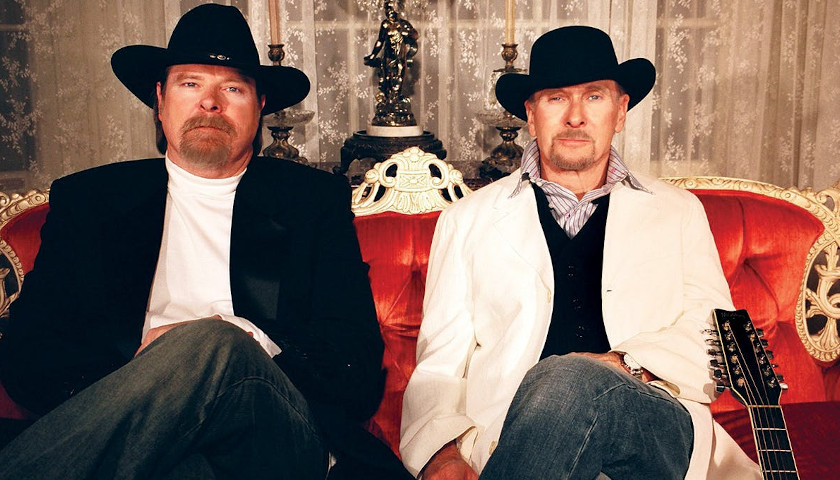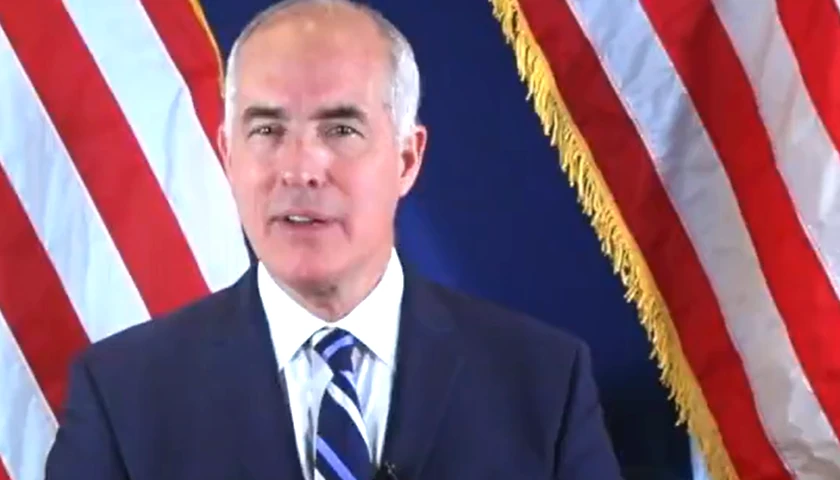Jim Seals, co-founder of internationally successful soft-rock duo Seals and Crofts (pictured above, right, with brother Dan), died on Monday, after a lingering illness following a stroke in 2017. Seals, who had homes in Costa Rica and Hendersonville, Tennessee, is believed to have been at his Tennessee home at the time of his passing.
The duo’s primary success came in the years between 1972 and 1977, though hits such as “Get Closer,” “Diamond Girl,” and “We May Never Pass This Way Again” have since become woven into the fabric of popular culture, continuing to permeate classic-pop formats across the board.
Seals and Crofts made a point of presenting reflective and quietly affirming messages, and are largely remembered today for their “feel good” music, though the twosome did commit one uncharacteristically controversial act at the height of their popularity. It’s now mostly forgotten, because the point of contention, a perceived anti-abortion ode called “Unborn Child,” was successfully kept off of commercial radio by pro-choice protestors who raised vehement objections to the song after its February 1974 release. Ironically, the news of Seals’ death comes as the Roe v. Wade ruling that prompted the song’s lyrics is poised to potentially be overturned by the Supreme Court. “Unborn Child” (which will be examined in more depth in this extended tribute to the late Seals, his career, and his memorable work) still speaks powerfully to the issue of preserving human life in the womb, despite its suppression nearly 50 years ago.
Both Seals and musical partner Darrell “Dash” Crofts are natives of rural West Texas who spent time living in Nashville after the peak of their multi-million-selling career, which they launched from Los Angeles. The late Seals’ extended, Nashville-linked musical family includes performing younger cousin Brady Seals (formerly of country act Little Texas) and pop-turned-country star Dan Seals, who preceded his older brother Jim in death in 2009. The brothers joined forces in the early 2000s for occasional live performances as Seals and Seals, combining the hits of Seals and Crofts, England Dan (Seals) & John Ford Coley, and the younger Seals’ numerous high-charting country songs.
Jim (often referred to as Jimmy) Seals and Dash Crofts’ friendship and musical adventures began in their adolescence, and the two exhibited brother-like qualities of their own. For one, the compatibility between their unusually reedy, high-register voices suggested sibling harmony, lending the duo an instantly recognizable sound. This fact of physiology had an added advantage: it allowed their voices to cut crisply through the AM radios on which they would later become omnipresent beginning in the early 1970s.
Walking in fraternal tandem, working together as young, touring rock ‘n’ roll musicians launching their professional careers in the late 1950s, they would simultaneously arrive at a life-changing faith transition that would in turn inform their organically textured original music, uniquely fashioned from the pair’s broad palette of shared tastes, which included jazz, soul, folk balladry, and, inevitably, the Texas roots music they grew up hearing and/or playing on porches – sometimes their own.
In addition to playing saxophone – an instrument Seals embraced at age 13 after hearing saxes blaring raucously behind rock ‘n’ roll pioneer Little Richard – the budding musician was already a fiddling prodigy. At age 9, he beat out seasoned adult players to take home the 1952 state championship in the Texas Fiddlers Contest and Reunion.
Working locally with Crofts, then a drummer, Seals and his sax had the requisite honk to fill a vacancy in The Champs, an act whose sole smash hit, 1958’s “Tequila,” was saxophone-driven. The Champs had also lost their drummer, which allowed Seals and Crofts to hit the road together, experiencing all the exhilaration and liberty of the rock ‘n’ roll life. On their first date with The Champs, in Baton Rouge, Louisiana, a group of about 200 fans “went crazy when they saw us and started ripping at our clothes. It was like Beatlemania,” Seals told TexasMonthly’s Michael Hall.
The kindred twosome simultaneously grew weary of rock’s rattle and rasp in the later ’60s, as the genre began erupting with increasingly unrestrained, high-decibel expressions of social discontent and sexual liberation. Others, too, felt the same tremors, and began to seek spiritual solutions. But while some young adults were turning on to Eastern religion, thanks to The Beatles and other high-profile celebrities touting guru Maharishi Mahesh Yogi’s teachings during 1967’s “Summer of Love,” Seals and Crofts were in fact learning of a very different spiritual path: the Bahá’í religion.
As adherents of the Bahá’í faith who embraced a belief in the unity of all world religions and the inherent value of all humankind, Seals and Crofts sought to express the essence of their growing faith and its loving, life-affirming principles in their still-developing musical collaborations. The gentle, thoughtful style of music Seals and Crofts were beginning to create would become a linchpin in the emerging Southern California light-rock sound that largely defined commercial pop in the 1970s.
Their musical style and particularly their sentiments stood out as something of an anomaly among those of their contemporaries, many of whom espoused liberal views and encouraged personal, pleasure-centered freedoms including the use of illegal drugs and the practice of non-matrimonial “free love.” The duo’s failed first Warner Bros. single, 1971’s genial “When I Meet Them,” became a fan favorite and later appeared in an updated version on the duo’s two-million-selling greatest-hits collection after initially stalling at No. 104. Had it caught fire on the airwaves, the duo might have been perceived as misplaced hippie holdovers in the song, which promoted benevolent goodwill among all people – a dimming ideal of disillusioned and distracted youths who had sung along mere months earlier to The Youngbloods’ anthemic hit “Get Together,” urging them to smile on your brother, love one another right now.
In any case, the duo’s fledgling fling at the pop charts fell on deaf ears among radio programmers and tastemakers:
In this tiny little world, people’s all we got
Have we forgotten, have we forgotten how to love, how to love?
I want to shake everybody’s hand now, talk about the good times
Make each minute count and love my brothers and sisters
When I meet them, when I meet them …
As the ’70s began to unfold, the songs of social and political protest popularized in the late 1960s and followed by a subsequent ripple of secular spirituality – featuring such ragtag religious explorations as the theologically dodgy but appealingly supercharged boogie-rocker “Spirit in the Sky” and George Harrison’s Hare Krishna-inspired devotional “My Sweet Lord” – had largely given way to less topical radio hits that focused on surefire commercial formulas intended to tickle ears and set toes to tapping. The sublime “Summer Breeze,” which shot to No. 6 and set Seals and Crofts’ career into motion, hit those commercial targets but did so with a more sophisticated sound and a more nuanced message than most.
The song’s lyrics rang with images of idyllic but simple domestic life: curtains in the window, a rolled newspaper on the driveway, a home-cooked meal after a hard day’s work, and the arms that reach out to hold me, in the evening when the day is through. It was hardly subversive, but the tranquil song’s lyrics spoke to notions uncommon in mass-market pop: being settled and stable, living in committed relationship, and finding daily pleasures in doing what average people do.
Surely, raising a family was not far off in such a scenario. Dash Crofts, speaking to a studio audience gathered for a May 1974 performance on Chicago PBS station WTTW’s Soundstage series, mentioned how grateful he and Jim had been for the opportunity to spend four days in Chicago surrounded by family members, an occurrence that steady touring made all too rare. He followed by saying, “We’re gonna let you in on the the two sources of inspiration for our music, and our lyrics … one of them is our families, and the other one is our faith.”
Singing to their wives at that family-attended taping, Seals and Crofts performed their personalized tribute “Ruby Jean and Billie Lee,” a song that puts flesh on Crofts’ affirmation of family and faith being key to their work.
One of the duo’s most affecting numbers, it positions matrimony, family, and religious devotion as a single, unified life goal, with each man honoring both their higher power and their mate: He is the object of our longing / And we’re his creation. By extension, it projects this ideal onto their children: They won’t be torn by war / Nor will they kill or hate / Or hesitate to love justice. It’s hard to imagine listening passively to this track; all the more so now, in light of its opening verse’s breathtaking tenderness toward the now-widowed Ruby Jean Seals and the couple’s expressed hopes for their three now-adult children.
One could argue that Seals and Crofts might have scored higher chart positions and sustained their commercial momentum longer had they not felt compelled to challenge and hopefully enrich listeners with contemplative and upward-looking songs like the delicate, esoteric “Hummingbird” (No. 20, 1973) and the mortality-conscious “We May Never Pass This Way Again” (No. 21, 1973). In between those singles, they again reached No. 6 with “Diamond Girl,” a song perhaps unjustly bested on the charts by, among others, Deep Purple’s eternally churning but lyrically vaporous “Smoke on the Water” and ace songwriter Jim Croce’s lowest-end achievement, the lightweight caricature and now-VFW-dance standby “Bad, Bad Leroy Brown.”
Still, four consecutive Top 20 pop hits in less than two years’ time (they hit consistently higher marks on the demographically specific Adult Contemporary chart) was no small feat. The duo’s momentum was hitting a crest, and they traveled in a private jet but met willingly with fans after their concerts to answer a burgeoning number of questions regarding the faith-inspired expressions that wafted alluringly from their music. Seals and Crofts, who lived according to their values, appeared to have the best of both worlds, and to have sidestepped the pitfalls that wide-scale success can deliver to the back door.
By all indications, they were in position to have a massively successful year in 1974. However, their decision to start the year off by releasing “Unborn Child,” a song some viewed as a shot fired against 1973’s Roe v. Wade ruling, would limit radio airplay of new Seals and Crofts material for the entire year. The song’s lyrics were written by a close associate of Seals and Crofts, current Nashville resident Lana Bogan, after she watched a television documentary about abortion. Troubled by what she’d seen, especially in light of the Supreme Court’s then-recent decision to limit restrictions on abortion, Bogan wrote a poem from the perspective of a person lamenting a mother’s choice to abort her baby, encouraging the mother to think long-term about making such a decision.
Oh, unborn child, beginning to grow / Inside your mama, but you’ll never know
Oh, tiny bud, that grows in the womb / Only to be crushed before you can bloom …
Mama stop! Turn around, go back, think it over …
Oh no, mama, just let it be / You’ll never regret it, just wait and see
Think of all the great ones who gave everything
That we might have life here, so please bear the pain …
“Warner Brothers warned us against [releasing] it,” Crofts told music journalist Bill DeYoung. “They said, ‘This is a highly controversial subject, we advise that you don’t do this.’ And we said, ‘But you’re in the business to make money; we’re doing it to save lives. We don’t care about the money.'”
Those concerns were not unfounded: “Unborn Child” met with a near-immediate backlash, with the National Organization of Women (NOW) leading the pack to demand that radio stations refuse to air the song. It peaked at only No. 66 on the charts, and the comparatively innocuous follow-up single, “The King of Nothing,” only reached slightly higher at No. 60. Damage had indeed been done; the trio of Seals and Crofts singles that followed in 1975 and early ’76 only yielded one barely-Top 20 song. The duo would not again reach the pop Top 10 until 1976’s more romantically slanted “Get Closer,” their final release to accomplish that chart position and their next-to-last single to enter the Top 20 for the remainder of the decade.
In spite of their strong beliefs regarding monogamous relationships, sex within the marriage covenant only, and the sanctity of all human life, Bahá’ís routinely espouse acceptance for others’ choices and strive to steer clear of cultural controversy. So, it was not with an intention of protest, per se, that Seals and Crofts had opted to make “Unborn Child” their first 1974 single and the title of their strikingly illustrated sixth album.
“[The song] was really just asking a question: What about the child?” Seals said in a 1978 Miami Herald interview. “We were trying to say, ‘This is an important issue,’ that life is precious and that we don’t know enough about these things yet to make a judgment. It was our ignorance,” Seals allowed, “that we didn’t know that kind of thing was seething and boiling as a social issue.”
“On one hand we had people sending us thousands of roses, but on the other people were literally throwing rocks at us. If we’d known it was going to cause such disunity, we might have thought twice about doing it. At the time it overshadowed all the other things we were trying to say in our music.”
One of the non-physical rocks was hurled by NOW – the women’s organization co-awarded its sarcastic annual “Keep Her in Her Place” prize to Seals and Crofts for “Unborn Child” along with Paul Anka for his comeback hit, “(You’re) Having My Baby.” Both then and now, more vitriol has been aimed at the latter, which reached the No. 1 position in the country and evidently appeared to pose more of a threat as the believed-to-be first hit song, and certainly the first post-Roe v. Wade hit song, to openly glorify maternity (viewed by its detractors as chauvinism) and indirectly address abortion in a less-than-celebratory light.
I can see it, your face is glowin’
I can see it in your eyes, I’m happy you know it
That you’re havin’ my baby …
Didn’t have to keep it
Wouldn’t put you through it
You could have swept it from your life
But you wouldn’t do it, no, you wouldn’t do it
The record featured duet singer Odia Coates, who on alternate verses presented the blessed event-to-be from a female perspective, but this attempt at balancing the message did little to take the gun sights off of Anka. The performer would eventually change that key line of the song in live performance to “you’re having our baby,” in response to many who protested the use of the masculine-specific “my” baby (a choice that phenomenally successful songwriter and “My Way” composer Anka later defended as a word selected to flow more smoothly when sung).
Compared to “Unborn Child,” which explores the actual issue of abortion much more sensitively and dramatically, Anka’s saccharine latter-day hit doesn’t seem to merit the amount of negative attention it has continued to receive from opponents. It appears, too, that those who voiced the loudest opposition to the song overlooked its clear reference to choice (didn’t have to keep it … ). The song is acknowledging the woman’s choice and her husband’s pleasure, in tandem with her own, that she has made the choice to give birth. Such instances of protest might lead one to believe that the most aggressive promoters of choice may perhaps be intending only to promote a preferred choice, not the actual notion of the freedom to choose.
A similar situation presented itself more than decade later with Madonna’s “Papa Don’t Preach,” a song whose protagonist is faced with the difficult decision of whether to carry a child conceived out of wedlock.
Papa don’t preach, I’m in trouble deep
Papa don’t preach, I’ve been losing sleep
But I made up my mind, I’m keeping my baby
I’m gonna keep my baby …
At the time, feminist attorney Gloria Allred, speaking on behalf of the National Organization for Women (NOW) and other similarly-minded organizations, said, “This song has me very concerned, because it’s being used by anti-abortion groups to encourage young women to have their babies instead of having an abortion.” In her statement, she challenged Madonna, suggesting that the megastar should, in all fairness, also release a song that represents the opposite outcome of the one in “Papa Don’t Preach.”
Madonna, who caught fans and observers off-guard by reversing the typically independent and permissive stance demonstrated on her previous recordings, didn’t seem to mind the attention; she took the song to the top of the charts for two weeks in the summer of 1986.
While Seals and Crofts suffered more collateral damage on the front line of the Roe v. Wade firestorm – simply for defending their Bahá’í faith’s teaching (which aligns with contemporary scientific and medical findings) that life begins at conception – the 1974 single’s failure at commercial radio was hardly the end of the story. Their record sales (including songs on popular movie soundtracks such as One on One) and demand for public appearances continued at respectable levels until the early 1980s, when the emergence of disco sounded the death knell for the kind of introspective soft-rock music in which Seals and Crofts had specialized.
Though the single received minimal airplay nationwide, the duo continued to perform “Unborn Child” for concert audiences and on televised appearances. In April of ’74, Seals and Crofts were co-second-billed (with Black Sabbath) for the massive California Jam rock festival, which set records for the then-highest paid attendance (250,000) and highest gross – as well as the highest volume, utilizing a record-breaking hybrid sound system. The striking contrast between the low-key, high-minded Seals and Crofts and coarser hard-rock crowd-pleasers such as Sabbath and Deep Purple couldn’t have been plainer, but this was the era (in fact, it was near the close of the era) when stylistic diversity and creative latitude still ruled the day. One of the reported highlights of the festival was Jim Seals’ joyous, foot-stomping fiddle hoedown, which – amplified through the world’s then-most powerful sound system – set half a million hands to enthusiastic clapping.
ABC-TV televised the California Jam festival in four segments during May and June of ’74, with Seals and Crofts featuring on the final installment. In addition to playing for a quarter of a million listeners at the Jam itself, they were viewed weeks later by millions more who tuned in to hear a set that included hits as well as the lesser-known “Unborn Child.” Their filmed California Jam performance, which was met with explosive applause from Jam attendees, indicates that the song’s life-affirming message may not have been as widely objectionable as some might suggest.
A month after the duo’s televised Jam appearance aired in late June, journalist Geraldo Rivera interviewed the duo between performances on an episode of the talk/variety show Good Night America. After Seals and Crofts played “Unborn Child,” Rivera engaged them about their religious views, about the controversial song, and about public reaction to it.
“It’s been really, mostly positive,” Crofts said in response. “All the letters that we get, maybe anywhere from 150 to 500 a day, and out of all of those letters, maybe eight or nine of them are negative letters. It’s surprising to me, because I expected a lot of negative mail.” Crofts went on to reiterate his faith-based beliefs about life beginning at conception, adding, “this was something that a lot of doctors had argued about, when [life] really begins. And that was the motive behind the song. It wasn’t an attempt to get at the law, or to be anti-this or anti-that … but I think [abortion] should be the exception instead of the rule.”
Seals’ comments contained a bold prediction: “I feel that, after reading what I’ve read, the different articles … that in the future they’ll have different laws.” Seals went on to speculate that “A lot of abortion is done out of the fear and the frustration, and just a lack of knowledge, I think. And if this [song] could help somebody in that situation, then our job is done. We felt like it would be a contribution.”
In partnership with Dash Crofts, who survives his longtime friend, Jim Seals made numerous contributions to the welfare of the culture through enduring music that sought a kinder, higher ideal than most of the duo’s pop-chart contemporaries. The impact of his and Crofts’ spiritually informed body of work, and of the collective effect of “Unborn Child,” cannot be calculated. Still, it’s a given that their music, like the serene image in their still-sublime “Summer Breeze,” continues to blow like the scent of jasmine through countless hearts and minds.
– – –
Steve Morley is the copy editor for The Star News Network.
Photo of Jim and Dan Seals by Seals and Crofts.





